The application range for a torque air wrench spans numerous industries where precise fastener tension is required for mechanical integrity, safety compliance, and product reliability. In automotive manufacturing and repair, the torque air wrench ensures critical components such as wheel lug nuts, cylinder heads, and suspension elements are properly secured to manufacturer specifications. The construction industry utilizes these tools for structural steel connections, mechanical system installations, and heavy equipment maintenance where specified torque values must be consistently achieved. The manufacturing sector employs torque air wrench tools on assembly lines for products ranging from industrial machinery to consumer appliances, ensuring uniform product quality through consistent fastening tension. The versatility of the torque air wrench makes it applicable wherever controlled rotational force is needed for mechanical fastening operations.
Selecting an appropriate torque air wrench requires understanding several technical specifications that determine its suitability for particular applications. The torque range indicates the minimum and maximum force the tool can apply, typically measured in Newton-meters (Nm) or foot-pounds (ft-lb). The square drive size—commonly 1/2 inch, 3/4 inch, or 1 inch—must match the sockets required for the fasteners being tightened. Air consumption requirements determine the necessary compressor capacity to operate the torque air wrench effectively. The physical dimensions and weight of the tool affect its maneuverability in confined spaces. Some torque air wrench models feature adjustable torque settings with visual indicators or digital displays, while others are preset to specific values for specialized applications. Understanding these specifications ensures selection of a torque air wrench that matches both the technical requirements of the fastening tasks and the practical constraints of the working environment.
The advantages of using a torque air wrench extend beyond simple time savings to include improved quality control, reduced physical strain on workers, and enhanced safety outcomes. The consistent accuracy of a properly calibrated torque air wrench eliminates the variability inherent in manual tightening methods, ensuring every fastener meets specification without under-tightening or over-tightening. This consistency is particularly valuable in production environments where uniform quality is essential. The pneumatic operation of the torque air wrench reduces the physical effort required from operators, minimizing fatigue and potential injury from repetitive manual tightening. From a safety perspective, the proper use of a torque air wrench ensures critical connections maintain their integrity under operational stresses, preventing failures that could lead to equipment damage or personal injury. These combined benefits make the torque air wrench a valuable investment for any operation requiring reliable and precise mechanical fastening.
